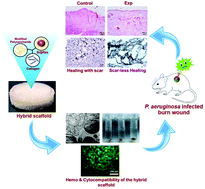Silica microsphere–resorcinol composite embedded collagen scaffolds impart scar-less healing of chronic infected burns in type-I diabetic and non-diabetic rats†
Abstract
The existence of diabetes and microbial infection in burn wounds makes the healing process more complex. Herein, we synthesize a collagen based hybrid scaffold incorporated with a silica–resorcinol composite and cross-linked with an oxidized fenugreek seed polysaccharide to stimulate scar-less healing in chronic wounds with type-I diabetes and microbial infection. The spectroscopic analyses of the hybrid scaffolds reveal the chemical and structural integrity of collagen. The hybrid scaffolds are shown to be appropriate for in vivo tissue regeneration through cytocompatibility and hemocompatibility studies. Scaffolds were applied to diabetic albino rats induced with chronically infected burn wounds with respective controls. Histological and immunohistochemical analyses of the granulation tissue collected from the hybrid scaffold treated animal groups showed improved angiogenesis, reepithelialization and TGF-β3 expression, which eventually led to scar-less wound healing. The results confirm that the prepared hybrid collagen scaffold could be used for effective scar-less wound healing in chronic burn wounds.



 Please wait while we load your content...
Please wait while we load your content...